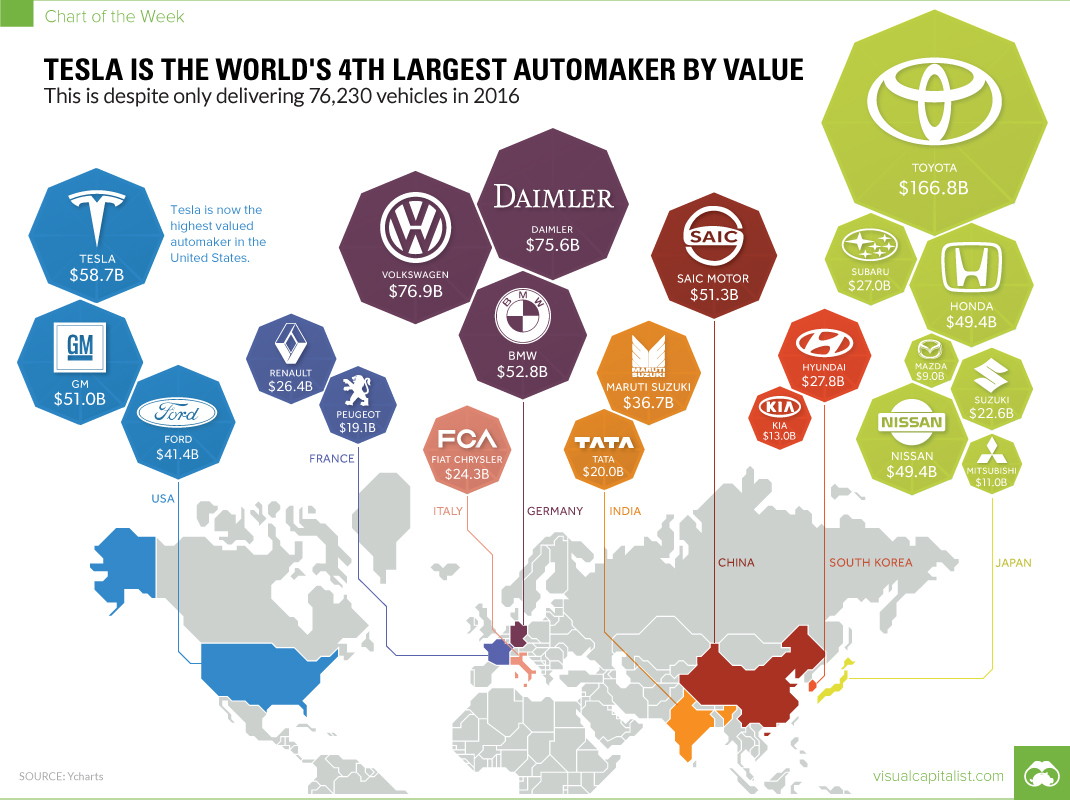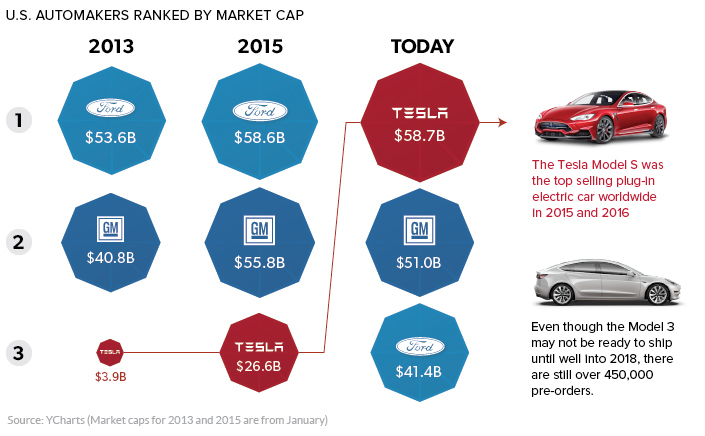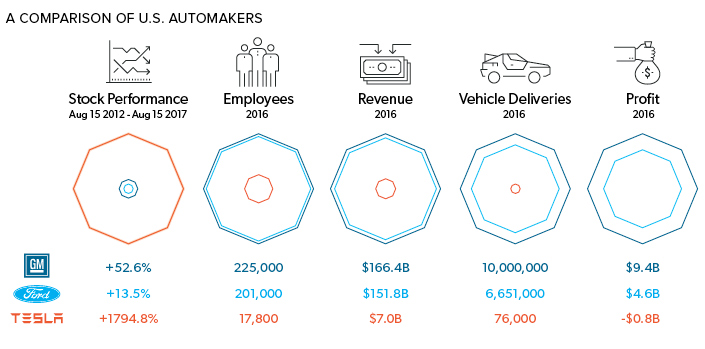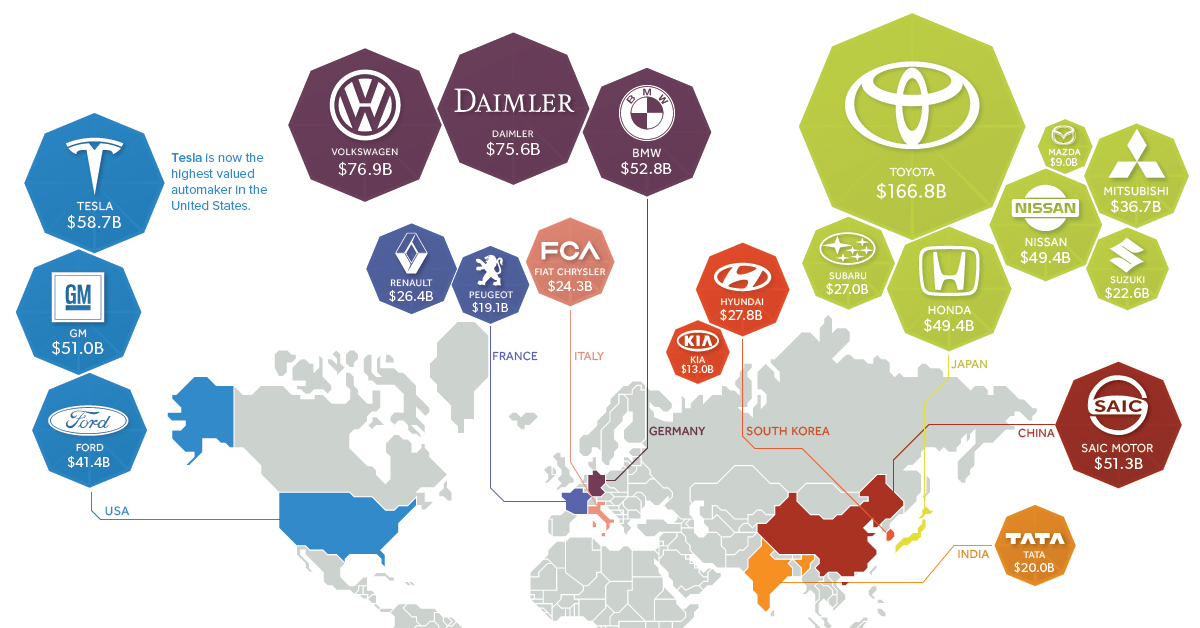Technology
The World’s Largest Automakers, By Market Value

Tesla is the World’s 4th Largest Automaker by Value
This is despite only delivering 76,230 vehicles in 2016.
The Chart of the Week is a weekly Visual Capitalist feature on Fridays.
It’s been another breakout year for Tesla.
Over the course of 2017, the company’s market capitalization has soared beyond those of major manufacturers like Ford, GM, BMW, Honda, and Nissan. This thrust can be partly attributed to the company’s Model S, which reigns supreme as the top-selling plug-in electric car worldwide in 2015 and 2016.
But more importantly for Tesla, this massive momentum is based on the company’s much-anticipated future performance. Investors and analysts eagerly anticipate progress as the company ramps up production of the more affordable Model 3, and many also strongly believe that Elon Musk brings an “X Factor” that could translate into future returns.
In today’s charts, we look at Tesla’s ascent in valuation to become the #4 ranked automaker globally, and also the #1 maker in America. We also show why the value assigned to Tesla’s astonishing valuation may be premature, at least based on conventional metrics.
Tesla’s Rapid Ascent
In the opening months of 2013, Tesla was just starting to plan deliveries for its Model S. At the time, the company was worth a mere $3.9 billion – just 7% of the value of Ford.
Since then, Tesla’s value has skyrocketed to make it the most valued auto company in North America:

Despite only producing 76,230 vehicles in 2016, Tesla is now the biggest of the “Big 3” – and this puts a lot of pressure on the company to live up to the vast expectations held by investors and media.
The Speculator’s Gambit
With so much hype and value assigned to expectations of future performance, Tesla and its enthusiastic investors are in a potentially tough spot.
Even though it is the most valued car company in the United States, Tesla is much less impressive by more conventional metrics:

The company has just a fraction of the employees, vehicle deliveries, and revenue of its competitors. Tesla also treads a similar path to Amazon, in that it will likely take a while for the company to ever post a profit.
Here’s another look, this time showing Tesla’s metrics as a percentage of GM’s:
| Metric | Tesla | GM | Tesla (as a % of GM) |
|---|---|---|---|
| Employees (2016) | 17,800 | 225,000 | 7.9% |
| Vehicle Deliveries (2016) | 76,000 | 10,000,000 | 0.8% |
| Revenue (2016) | $7.0B | $166.4B | 4.2% |
| Profit (2016) | -$0.8B | $9.4B | n/a |
Tesla is producing less than 1% as many cars as GM, but is worth more in market value.
That’s not to say that Tesla will not ultimately live up to expectations – but it does put into perspective the risk of banking on these future returns.
Technology
Ranked: Semiconductor Companies by Industry Revenue Share
Nvidia is coming for Intel’s crown. Samsung is losing ground. AI is transforming the space. We break down revenue for semiconductor companies.
Semiconductor Companies by Industry Revenue Share
This was originally posted on our Voronoi app. Download the app for free on Apple or Android and discover incredible data-driven charts from a variety of trusted sources.
Did you know that some computer chips are now retailing for the price of a new BMW?
As computers invade nearly every sphere of life, so too have the chips that power them, raising the revenues of the businesses dedicated to designing them.
But how did various chipmakers measure against each other last year?
We rank the biggest semiconductor companies by their percentage share of the industry’s revenues in 2023, using data from Omdia research.
Which Chip Company Made the Most Money in 2023?
Market leader and industry-defining veteran Intel still holds the crown for the most revenue in the sector, crossing $50 billion in 2023, or 10% of the broader industry’s topline.
All is not well at Intel, however, with the company’s stock price down over 20% year-to-date after it revealed billion-dollar losses in its foundry business.
| Rank | Company | 2023 Revenue | % of Industry Revenue |
|---|---|---|---|
| 1 | Intel | $51B | 9.4% |
| 2 | NVIDIA | $49B | 9.0% |
| 3 | Samsung Electronics | $44B | 8.1% |
| 4 | Qualcomm | $31B | 5.7% |
| 5 | Broadcom | $28B | 5.2% |
| 6 | SK Hynix | $24B | 4.4% |
| 7 | AMD | $22B | 4.1% |
| 8 | Apple | $19B | 3.4% |
| 9 | Infineon Tech | $17B | 3.2% |
| 10 | STMicroelectronics | $17B | 3.2% |
| 11 | Texas Instruments | $17B | 3.1% |
| 12 | Micron Technology | $16B | 2.9% |
| 13 | MediaTek | $14B | 2.6% |
| 14 | NXP | $13B | 2.4% |
| 15 | Analog Devices | $12B | 2.2% |
| 16 | Renesas Electronics Corporation | $11B | 1.9% |
| 17 | Sony Semiconductor Solutions Corporation | $10B | 1.9% |
| 18 | Microchip Technology | $8B | 1.5% |
| 19 | Onsemi | $8B | 1.4% |
| 20 | KIOXIA Corporation | $7B | 1.3% |
| N/A | Others | $126B | 23.2% |
| N/A | Total | $545B | 100% |
Note: Figures are rounded. Totals and percentages may not sum to 100.
Meanwhile, Nvidia is very close to overtaking Intel, after declaring $49 billion of topline revenue for 2023. This is more than double its 2022 revenue ($21 billion), increasing its share of industry revenues to 9%.
Nvidia’s meteoric rise has gotten a huge thumbs-up from investors. It became a trillion dollar stock last year, and broke the single-day gain record for market capitalization this year.
Other chipmakers haven’t been as successful. Out of the top 20 semiconductor companies by revenue, 12 did not match their 2022 revenues, including big names like Intel, Samsung, and AMD.
The Many Different Types of Chipmakers
All of these companies may belong to the same industry, but they don’t focus on the same niche.
According to Investopedia, there are four major types of chips, depending on their functionality: microprocessors, memory chips, standard chips, and complex systems on a chip.
Nvidia’s core business was once GPUs for computers (graphics processing units), but in recent years this has drastically shifted towards microprocessors for analytics and AI.
These specialized chips seem to be where the majority of growth is occurring within the sector. For example, companies that are largely in the memory segment—Samsung, SK Hynix, and Micron Technology—saw peak revenues in the mid-2010s.
-

 Maps2 weeks ago
Maps2 weeks agoMapped: Average Wages Across Europe
-

 Money1 week ago
Money1 week agoWhich States Have the Highest Minimum Wage in America?
-

 Real Estate1 week ago
Real Estate1 week agoRanked: The Most Valuable Housing Markets in America
-

 Markets1 week ago
Markets1 week agoCharted: Big Four Market Share by S&P 500 Audits
-

 AI1 week ago
AI1 week agoThe Stock Performance of U.S. Chipmakers So Far in 2024
-

 Automotive2 weeks ago
Automotive2 weeks agoAlmost Every EV Stock is Down After Q1 2024
-

 Money2 weeks ago
Money2 weeks agoWhere Does One U.S. Tax Dollar Go?
-

 Green2 weeks ago
Green2 weeks agoRanked: Top Countries by Total Forest Loss Since 2001












